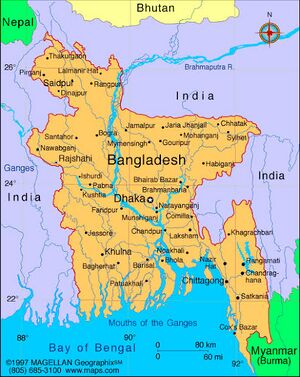Pundravardhana
| Author:Laxman Burdak, IFS (R) |

Pundravardhana (पुंड्रवर्धन) was a Bhukti in Pundradesha during Gupta dynasty which included many Varshas like Kotivarsha.
Origin
Variants
- Pundravardhana पुंड्रवर्धन, बंगाल, (AS, p.563)
- Pundravardhana-bhukti
- Pundravardhanabhukti
- Pundravardhana Bhukti
History
Tej Ram Sharma[1] writes that Pundravardhana (पुण्ड्र वर्धन) is mentioned in Gupta Inscriptions (No. 28, L.I; No. 33, LL .1-2; No. 34, L. 2 ; No. 35, L.2; No. 36, L. 2;- No. 37, L. 2; No. 43, L. 14) :
This bhukti is mentioned in the Gupta epigraphs ranging from the years 124 to 224 of the Gupta era, i.e. from A.D. 443 to 543. It formed an integral part of Gupta empire during this period. According to Inscription No. 37, a noble man (kulaputra) Amrtadeva by name belonging to Ayodhya approached the local government of Kotivarsa of which Svyambhudeva was the governor, under the provincial government of Pundravardhana-bhukti, during the reign of Bhanugupta, and prayed that he might be given, by means of a copper-plate document in accordance with the prevailing custom, some rent-free waste lands. His prayer was granted.
General Cunningham 52 identifies Pundravardhana with the extensive ruins known as 'Mahāsthāngarh', 8 miles north of the town of Bogra. The river Karatoya was the dividing line between Pundravardhana-bhukti and Kamarupa. 53 According to Wilson, the ancient kingdom of Pundradesa included the districts of Rajshahi, Dinajpur, Rangpur, Malda, Bogra and Tirhut. 54 It seems to have been the biggest administrative division or province of the Gupta empire, divided into several visayas and mandalas of which twenty-four 55 are mentioned
Personal and geographical names in the Gupta inscriptions 213
in known epigraphs. In short Pundravardhana signified North Bengal.
Pundravardhana, as the name suggests, was a settlement of the Pundras. 56 The first reference to the Pundras is found in the Aitareya Brahmana. 57 The earliest literary reference to Pundravardhana is to be traced in the Buddhist work, the Divyavadana, where it is mentioned as the easternmost city of India. 58 The Paundra country is mentioned also in the Brhat-sarhhita, 59 as situated in the east. 60 The Kavyamimamsa also mentions it as a Janapada in the east. In the inscriptions of Bengal the name Pundravardhana was changed into Paundravardhana in the early part of the 12th century, when it occurs first in the Manahali grant of Madanapala and remained in use till the end of the Sena rule. The Rajatarangini mentions Pundravardhana as the capital of Gauda which is also proved by a reference in Purusottama's lexicon (llth century A.D.) 61
The city lost its importance from the third quarter of the 12th century A.D. as the later Sena kings shifted their capital to Gauda in the Malda district. Towards the end of the 13th or the beginning of the 14th century A.D. Pundravardhana was occupied by the Muhammedans. 62
43. Sanskrit-English Dictionary by Monier Williams. p. 759, col. 3.
44. A.S. Altekar, (Sir Asutosh Memorial Volume ) 2 , p. 202.
45. Ibid., Epigraphia Indica. XXV, p. 265.
46. Epigraphia Indica. XV, pp. 129 ff. 'When the Mitakara on Yaj. I. 319 states that only a king can make the grant of land and not a bhogapati, it is obviously referring to the head of this large territorial division' vide Ibid.; Altekar, (Kz) 2 , p. 202 f.n. 2.
47. A.S. Altekar, (Sir Asutosh Memorial Volume) 2 , p. 202.
48. Ibid., p. 203.
49. N.L. Dey, Geographical Dictionary of Ancient and Medieval India. Preface p. i.
50. K.K. Gopal, Indian Historical Quarterly, Calcutta ., March and June 1963, p. 81.
51. Corpus Inscripionum Indicarum, Vol. III by John Faithful Fleet , p. 216, L. 6.
52. Archaeological Survey of India, Annual Reports . Vol. XV, pp. 104-117 : Epigraphia Indica. XX, p. 61.
53. B.C. Law, Historical Geography of Ancient India. p. 243.
54. Visnu Pur ana, II, pp. 134, 170 :Dey, Geographical Dictionary of Ancient and Medieval India. p. 161.
55. R.C. Majumdar, The History of Bengal. Vol. I, pp, 24-25.
56. B.C. Sen, (Sir Asutosh Memorial Volume)1 p. 104.
270 Personal and geographical names in the Gupta inscriptions
57. VII, 18.
58. B.C. Sen, (Sir Asutosh Memorial Volume) 1 p. 104,.
59. XIV, p. 119, V. 7: उदयगिरिमद्रगौडकपौण्ड्रौत्कलकाशिमेकलाम्बष्ठा:
60. Kavyamimamsa Saptadasho adhyay p.235
61. N.L. Dey, Geographical Dictionary of Ancient and Medieval India. pp. 161-162 . B.C. Law, Historical Geography of Ancient India. p. 247.
62. B.C. Law, Historical Geography of Ancient India. p. 248.
पुंड्रवर्धन
विजयेन्द्र कुमार माथुर[2] ने लेख किया है .....पुण्ड्रवर्धन (AS, p.563) का उल्लेख गुप्तकालीन अभिलेखों में हुआ है। इन अभिलेखों से सूचित होता है कि गुप्त साम्राज्य में 'पुण्ड्रवर्धन' नाम की एक 'भुक्ति' थी, जो 'पुंड्र देश' के अंतर्गत आती थी। इसमें कोटिवर्ष आदि अनेक वर्ष सम्मलित थे। इन ताम्रपट्ट लेखों से सूचित होता है कि लगभग समग्र उत्तरी बंगाल या पुंड्र देश, पुंड्रवर्धन भुक्ति में सम्मलित था और यह 443 ई. से 543 ई. तक गुप्त साम्राज्य का अविछिन्न अंग था। यहाँ के शासक 'उपरिक महाराज' की उपाधि धारण करते थे और इन्हें गुप्त नरेश नियुक्त करते थे। कुमारगुप्त प्रथम के समय में उपरिक चिरातदत्त को पुण्ड्रवर्धन का शासक नियुक्त किया गया था और बुधगुप्त के समय (163 गुप्त सम्वत या 483-484 ई.) में यहाँ का शासक ब्रह्मदत्त था। सम्भवत: पुण्ड्रवर्धन भुक्ति का प्रधान नगर वर्तमान रंगपुर के निकट रहा होगा। भारत के बिहार राज्य के पूर्णिया ज़िले में मौर्य सम्राट अशोक के स्तूप हैं। पूर्व में बंगाल तक मौर्य साम्राज्य के विस्तृत होने की पुष्टि 'महास्थान शिलालेख' से होती है। यह अभिलेख ब्राह्मी लिपि में है और मौर्य काल का माना जाता है। महावंश के अनुसार अशोक अपने पुत्र को विदा करने के लिए ताम्रलिप्ति तक आया था। ह्वेनसांग को भी ताम्रलिप्ति, कर्णसुवर्ण, समतट, पूर्वी बंगाल तथा पुण्ड्रवर्धन में अशोक के स्तूप देखने को मिले थे।

